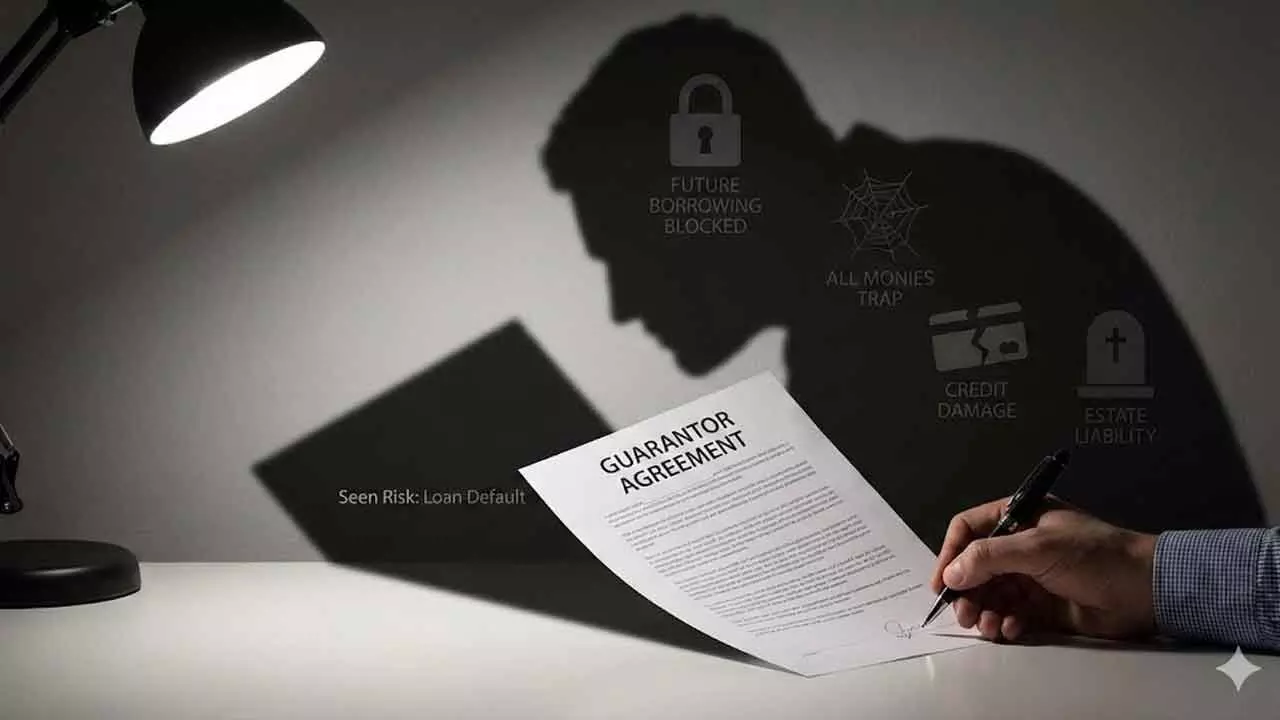What are unseen risks of being a guarantor
It’s an act of trust, often for a friend or family member. At the time, it might seem like a mere formality
What are unseen risks of being a guarantor

The lender assesses theirability to repay. They look at the existing EMIs versus the income. If the primary borrower defaults, the entire guaranteed loan amount becomes yourimmediate debt obligation in the eyes of the lender. This can drastically increase the DTI ratio, making one seem like a riskier candidate, even if their own finances are impeccable
Many of us act financially savvy. Keeping track of our spending, diligently manage the EMIs, pay the credit card bills on time, etc. Some even check their credit report regularly, scanning for errors, unrecognised loans or missed payments, making their financial destiny in control.
But, what if a hidden liability, one that was signed up years ago, out of goodwill is silently undermining, the credit worthiness? This ghost could be a loan for which one is a guarantor.
While most of us focus on the obvious factors like the outstanding loans, credit card usage, and repayment history, the role of a guarantor often fades from memory. Yet, it carries a very real and significant financial weight. It turns as an invisible handcuff, an unseen risk.
In simple terms, when one agrees to be a guarantor for someone else's loan be it a personal loan, car loan, or home loan, and even for a chit fund withdrawal, they’re not just providing a character certificate. One is entering a legal contract with the lender, pledging to repay the debt if the primary borrower defaults.
It’s an act of trust, often for a friend or family member. At the time, it might seem like a mere formality. You trust them, they’re financially stable, and you never expect to be called upon. So, you sign the documents and forget about it.But from a lender’s perspective, that guaranteed loan is a potential liability on your balance sheet.
Your credit health isn't just about your actions but it's about your obligations. Here’s how a guaranteed loan could haunt your creditworthiness.
Debt-to-Income (DTI) Ratio: When one applies for a new loan, say, for their dream home. The lender assesses theirability to repay. They look at the existing EMIs versus the income. If the primary borrower defaults, the entire guaranteed loan amount becomes yourimmediate debt obligation in the eyes of the lender. This can drastically increase the DTI ratio, making one seem like a riskier candidate, even if their own finances are impeccable.
A red flag: For assessing new credit, that guaranteed loan is often considered part of the overall exposure. If the loan is large, it can signal that one is already over-leveraged, or as increased credit utilization. This could potentially lead to loan rejection or even treated as a sub-prime borrower, providing an approval at a higher interest rate.
Hurting the credit report: Default of the borrower is the worst-case scenario. If the primary borrower (for whom one stands as guarantor) starts missing payments, those defaults are reported to the credit bureaus.Crucially, they appear on your credit report as well. Thus a single default, even on a loan you weren't directly paying, can cause a catastrophic drop in your credit score, taking years to recover from.
The legal and recovery nightmare: If the borrower vanishes or declares bankruptcy, the lender has every legal right to come after the guarantor for the entire outstanding amount. This can lead to stressful recovery calls, legal notices, and even the seizure of existing assets.
The best way to exorcise this ghost is to follow a checklist for financial clarity. Ignorance is not bliss in the world of personal financial management. The good news is that one can, and should, bring this potential liability into the light.
Scrutinize the credit report: This is the first line of defense. When one getshold of the free annual report from credit bureaus like CIBIL, Experian, or Equifax, don’t just look for loans in your name. Look for a section on "Guarantor" obligations. While not all guaranteed loans are always reported, many are, and this is the best chance to spot them.
Creating a "Guarantor Inventory": Sit down and make a list of every instance where you have stood as a guarantor. Note the borrower's name, the loan type, the amount, and the bank or the lender. This personal record will keep you informed and reviewed.
Communicate with the primary borrower: This can be an uncomfortable conversation, but a very necessary one. A simple, annual financial review to check that their loan is on track, can give you peace of mind. It also serves as a gentle reminder to the borrower about their responsibility.
Know your Exit Route: Before signing as a guarantor, understand the bank's policy for releasing a guarantor. Some loans allow for the guarantor to be removed once the loan-to-value ratio reaches a certain point or after a specific number of on-time payments. If the borrower’s financial situation has improved, you can formally request to be removed from the obligation. Read the detailed ink before committing.
Finally, helping a loved one is a noble act but be a smart Samaritan. In the financial world, goodwill must be backed by prudence.Before you sign on the dotted line as a guarantor, treat it with the same seriousness as taking a loan for yourself. Assess the borrower's financial discipline, be aware of the total loan amount, the tenure and understand the long-term implications for your own financial future.
Your creditworthiness is a fragile ecosystem. By accounting for all factors, particularly, the silent one of being a guarantor, one moves from just being careful to being truly credit empowered. Don't let a ghost from your past jeopardize the financial dreams of your future.
(The author is a partner at “Wealocity Analytics”, SEBI registered Research Analyst firm and could be reached at [email protected])

